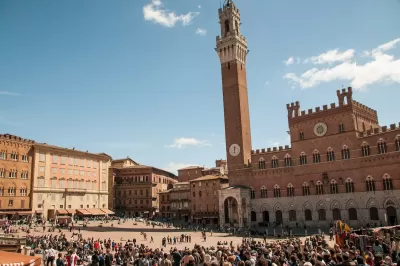This year’s gathering was full of promise, hope — and tension.

ISOCARP sounds like an outer planet in a dystopian movie, but in reality, it has zero sci-fi cred. ISOCARP stands for the International Society of Community and Regional Planners. (How do you know when a city planner is a sci-fi fan? They keep warning everyone about urban sprawl wars. “May the density be with you!”)
From October 8 to 12, 2024, I attended ISOCARP’s 60th anniversary World Planning Congress in Siena, Italy, having hoodwinked my husband, who’d traveled with me to Europe to celebrate our 15th wedding anniversary. Good food, good urbanism, and some good rain. What else could he have hoped for?
Siena is the city where the late great author, Italo Calvino, chose to live out his last days. Calvino’s beautiful book of prose poems, Invisible Cities, sits on many a city builder’s bookshelf. In homage to Calvino, ISOCARP 60th World Planning Congress had as its theme Reinventing the (in)visible cities.
Reflections of Siena in Calvino’s Invisible Cities
In the early aughts, I traveled by rail pass for a month in Italy, with a dog-eared paperback copy of Invisible Cities holding a dear place in my backpack and my thoughts. Calvino’s fictional version of Marco Polo describes fifty-five cities to the Emperor Kublai Khan. As the book winds to a close, the reader discovers that all of these cities are manifestations of Venice. Indeed, Calvino's text infers that all cities are mirrors of one another. Every city reflects humanity’s shared understanding of the forces of city building, as accumulated over many generations.
Diomira, one of Calvino’s Invisible Cities, hosts a scene of joyful travelers as they recall a single October evening, as the light faded with the season. Diomira is built of crystal glass and precious metals, but people’s memories last longer than anything earth-bound, more resilient indeed than Diomira’s sixty silver domes, its bronze statues of all the gods, its streets paved with lead.
In contrast, the Siena before me is a Gothic city of brick and stone, of narrow roads and lanes, of cafes and tourists. But it’s Diomira I held in my mind as I walked the streets of Siena. It’s said that Diomira is the place where travelers can consolidate their insights from their journeys. This is what I yearned for in Siena — new insights into city planning and urbanism.
I had my own single October evening in Siena when I strode across the circus-shaped Il Campo on the second evening of the World Planning Congress. The light was slowly fading, bouncing off the buildings that line the piazza. The joy Calvino had described in Diomira reflected my own. I relaxed into my younger self.
Noble goals and crucial questions
Siena’s World Planning Congress had been billed as a critical opportunity for urban planners to balance tradition and innovation while promoting sustainable growth. The conference focused on planning strategies that merge heritage conservation with innovation. The setting of Siena — an ancient city renowned for its medieval architecture — provided an evocative backdrop for these discussions.
A range of sessions facilitated knowledge exchange between planners and planner-friendly participants from around the world. In particular, the World Planning Congress highlighted how cities can tackle systemic inequalities by integrating social values into planning frameworks.
The conference sessions and workshops were a marathon of urbanist themes, covering everything from climate resilience to the slightly mind-bending “Practical Applications of Urban Circularity,” which I assume had us rethinking our daily interactions with trash bins. Some sessions were assembled under the auspices of the painfully academic theme of “Morphology, Parametrics, and Densities,” a title perhaps borrowed from a sci-fi series about the distant Planet ISOCARP.
Another of the conference’s themes — “Publicness, Well-being, and Inclusivity” — had me wondering what “publicness” might actually mean, but I loved that we went there. Indeed, for my fellow devotees of inclusivity, there were sessions such as “Inclusive Urban Design and Social Innovation,” “Community-Driven Approaches for Resilience,” and “Everyday Life: Housing, Place-Making and Neighborliness.”
In the spirit of the times, several presentations and workshops tackled “Technological Innovations for Climate Resilience” and “Digital Transformation and Smart Cities.” Some of the sessions explored the use of Artificial Intelligence (AI) as a tool for public engagement. This sparked interesting discussions — and humorous results. In one session, we were intended to witness how a live interview with a “member of the public” (in this case, a volunteer from the audience) could be fed into an AI system, adding significant value to the planning process in question, only to get extraordinarily wonky results — again, live. At least one other workshop participant wasn’t buying it. “I find myself skeptical of AI because we need more humanity in the world, not less,” he commented. “Especially when we think of big problems and how to fix big problems.”
A series of keynote speakers capped every day of the conference. My favourite was that of award-winning global advisor and urban strategist Orna Rosenfeld. She spoke compellingly about inclusion, and caught my attention with this statement in particular: “There is no universal heritage, heritage itself is universal — we all have heritage, and it belongs to everyone.”
If I looked around me with rose-coloured glasses at the conference goings-on, all seemed fine. However, signs of trouble soon became apparent.
Cracks begin to show
“A city is not gauged by its length and width, but by the broadness of its vision and the height of its dreams,” wrote Calvino in Invisible Cities. Organizations, too, need to have vision and to dream big. But they need a common vision and a common dream. The ISOCARP suffers under the weight of considerable tensions and its common vision has fallen away.
In the lead-up to the Congress, the society’s members received correspondence that pointed to fault lines. For example, we received an invitation to a Special General Meeting of the Society, called by the Board’s Secretary General, who said he was supported in his actions “by five other board members including the President-Elect and the Board Director for Membership Relations.” However, the invitation explicitly lacked the endorsement of the majority of the Board. From there, it only got worse. We received official notifications that the Special General Meeting, convened by the Secretary-General, was extrajudicial, and that lawyers were involved in some internal investigations. There were heavy accusations thrown around. There were attempts to oust a member of the Board.
It went from bad to worse. The AGM, held during the Congress, was acrimonious. Those of us who were new to the society didn’t know what to make of all the drama. At one point, the outgoing President and the incoming President, both with their own microphones in hand, tried to take control of the meeting by raising their voices over one another.
Despite the turmoil, the 60th World Planning Congress in Siena brought me several moments of pleasure. I met clever and dynamic planners from around the world. I also enjoyed an ISOCARP-hosted family-style feast held at one of Siena’s contrada halls, rife with history and the murmurs of convivial gatherings for the neighborhood dating back hundreds of years.
But the acrimony among ISOCARP’s leaders, among current Board members, and among the old guard and the new, led to a tense atmosphere and a fair amount of disorganization among the organizers.
If ISOCARP is an outer planet in a dystopic version of the universe, here’s hoping it will soon be more inhabitable.
Emilie K Adin is President of the Planning Institute of British Columbia and Yukon, and an Adjunct Professor at the School of Community and Regional Planning at the University of British Columbia.

Maui's Vacation Rental Debate Turns Ugly
Verbal attacks, misinformation campaigns and fistfights plague a high-stakes debate to convert thousands of vacation rentals into long-term housing.

Planetizen Federal Action Tracker
A weekly monitor of how Trump’s orders and actions are impacting planners and planning in America.

In Urban Planning, AI Prompting Could be the New Design Thinking
Creativity has long been key to great urban design. What if we see AI as our new creative partner?

King County Supportive Housing Program Offers Hope for Unhoused Residents
The county is taking a ‘Housing First’ approach that prioritizes getting people into housing, then offering wraparound supportive services.

Researchers Use AI to Get Clearer Picture of US Housing
Analysts are using artificial intelligence to supercharge their research by allowing them to comb through data faster. Though these AI tools can be error prone, they save time and housing researchers are optimistic about the future.

Making Shared Micromobility More Inclusive
Cities and shared mobility system operators can do more to include people with disabilities in planning and operations, per a new report.
Urban Design for Planners 1: Software Tools
This six-course series explores essential urban design concepts using open source software and equips planners with the tools they need to participate fully in the urban design process.
Planning for Universal Design
Learn the tools for implementing Universal Design in planning regulations.
planning NEXT
Appalachian Highlands Housing Partners
Mpact (founded as Rail~Volution)
City of Camden Redevelopment Agency
City of Astoria
City of Portland
City of Laramie




























